![]()
![]()
![]()
Use LEFT and RIGHT arrow keys to navigate between flashcards;
Use UP and DOWN arrow keys to flip the card;
H to show hint;
A reads text to speech;
29 Cards in this Set
- Front
- Back
|
central myelin is produced by _______ with SINGLE/MULTIPLE axon(s) invested, whereas peripheral myelin is produced by ______ with SINGLE/MULTIPLE axon(s) invested.
|
oligodendrocytes; multiple
Schwann cells; single |
|
|
name 2 disorders of central myelin
name 2 disorders of peripheral myelin name the general term for disorders of both central and peripherl myelin |
multiple sclerosis; post-infectious encephalitis
guillain-barre; charcot-marie-tooth dz leukodystrophies |
|
|
name the new imaging technique that's revoluationing our understanding of white matter tracts.
|
diffusion tensor imaging (DTI)
|
|
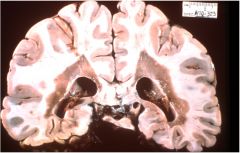
what is this showing? what dz is this?
|
demyelinating plaques in MS around the ventricles (periventricular), which is where MS tends to like to show up, but could occur anywhere in the CNS (LESIONS ARE DISSEMINATED IN SPACE AND TIME!!)
|
|
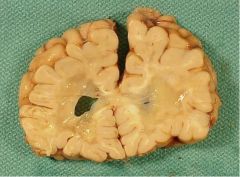
what dz is this showing? what could it present clincally?
|
multiple sclerosis; depeding on the tracts affected, could have sensory alterations including numbness/paresthesias, incoordination, diplopia due to oculomotor incoordination -- there's no rhyme or reason to the demyelination (fxnal consequences depennds on where the lesion is.)
|
|
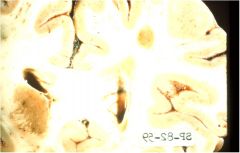
what is this showling? what age group and gender is this dz most common in?
|
demyelinating plaques in MS - 20-40 white females
Rule of thumb: in 5 yrs, the dz will stabilize - 1/3 of pts will have mild disability (capable of working and functioning), 1/3 of pts will have medium severity (painful, but still able to work), 1/3 of pts will have severe disability (impaired) ==> MS is not a death sentence necessarily |
|
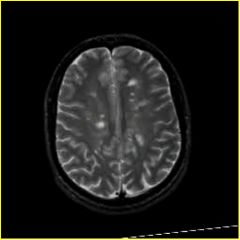
what imaging technique is valuable for detecting MS lesions? what is the best known cause of MS?
|
MRI - allows detection of asymptomatic plaques and aids in Dx (demonstrates dissemination in space/time)
- cuased by autoimmune dz in which oligodendroglia are targets |
|
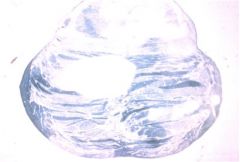
what stain is this for? what does this show, what dz specifically?
|
myelin stain; plaques from MS are shown here in the pons
|
|

what is this showing?
|
demyelination of the spinal cord (grey discoloration) so that demyelinated white matter tracts can't conduct info through them -- MS
|
|
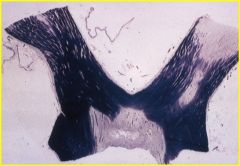
what is this picture showing?
|
Multiple sclerosis hitting the OPTIC CHIASM --
the Optic nerve is commonly hit, the MLF is commonly hit with MS. Young pts with INO or optic neuritis, you have to really think, could this person have MS? Do an MRI and see if there are any other lesions? If there are, pt should be started on longterm beta-interferon. |
|
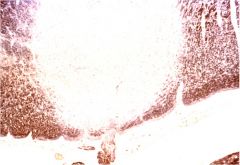
what dz is this showing and what specifically does this show up as clinically?
|
MS demyelination of nerve root entry zone (Demyelination slows conduction velocity and alters electrical excitability in the axon - sometimes the signals that get to this region will be sent into the CNS and misinterpreted by the CNS as pain)==> shows up as paroxysmal (sudden) pain - one of the causes of trigeminal neuralgia (CN5)
|
|
|
what would you typically find in the conduction velocity tests and CSF lab results for MS pt?
|
reduced conductance velocitis (indicating demyelination)
- CSF would have higher lymphocytes, inc protein, presence of oligoclonal bnads, presence of myelin basic protein (MBP) from breakdown of myelin ==> none of these lab findings can definitively conclude MS. you need MRI too |
|
|
with MS, there's perivascular lymphocytic infiltrate, loss of oligodendroglia, myelin sheath stripping, macrophage infiltration, astrogliosis. after this all, are the axons still relatively spared?
|
yes - which means you can still remyelinate. however, with chronic MS, much less reversible after attack after attack.
|
|
|
Tx for MS
|
immunosuppresion for acute exacerbations; but not longterm corticosteroids due to bad SEs.
chronic pts treated with alpha or beta-interferons -- immunomodulators to reduce freq and possibly the severity of attacks |
|
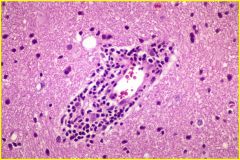
what is this showing?
|
perivascular lymphocytes in MS - since myelin loss occurs around small veins/venules accompained by lymphocytes/monocytes- they form plaques where oligodendrocytes are destroyed.
|
|
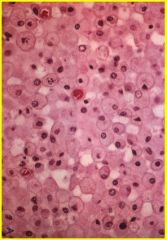
what does this show?
|
macrophages in demyelinating dz
|
|
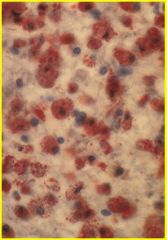
what does this show?
|
macrophages in demyelinating dz
|
|
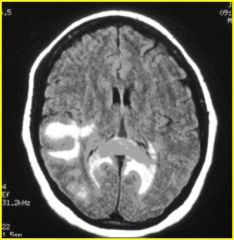
what dz is shown here? what are its characteristics?
|
post-infectious leukoencephalopathy (or acute hemorrhagic leukoencephalopathy)
- severe form of post-infectious demylination dz with characteristic multiple hemorrhages and necrosis seen |
|
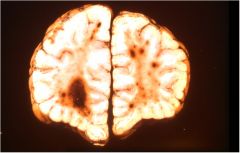
what dz is shown here? what is the milder form called?
|
post-infectious leukoencephalopathy (monophasic immune attack of CNS white matter) - aka. acute hemorraghic leukoencephalopathy
- acute disseminated encephalomyelitis (ADE) |
|
|
name syndrome that causes inflammatory polyradiculoneuritis (via peripheral demyelination)
|
guillain-barre syndrome
- May follow infection or vaccination -Rapid progression (peripheral weakness --> profound weakness involving respiratory muscles within hours to days) -May lead to respiratory failure |
|
|
Tx of guillain-barre
|
Can be treated with plasma exchange
Good outcome ultimately Can relapse or become recurrent |
|
|
what is importan about the lumbar puncture for guillain barre pt
|
you see really high protein in CSF due to blood nerve barrier being broken- -however, don't see very many cells
|
|
|
define leukodystrophies
if i had a baby who was born blind and spastic, what should i think? |
hereditary disorders of myelin metabolism ususally presenting in childhood (aka dysmyelinating disorders) ==> involves both central and peripheral myelin
metachromatic leukodystrophy |
|
|
metachromatic leukodystrophy is autosomal _____ deficeincy of what protein?
|
recessive; arylsulfatase (leads to accumulation of galactosyl-3-sulfatide (leads to PNS and CNS demyelination bc of sulfatide accumulation in EC matrix)
|
|
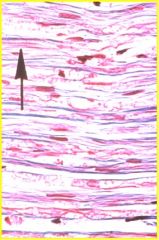
what pathology is imaged here? how would this show up clinically? how do you Dx it?
|
metachromatic leukodystrophy (on toluidine blue stain, product is BROWN)
clinically, would show up as mental retardation, spasticity, blindness dx by lack of aryl sulfatase A in urine |
|
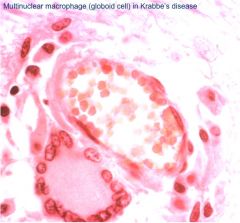
what pathology is shown here? what are the genetics of it and what does that affect? when do sx's begin and how long before death occurs?
|
krabbe's leukodystrophy
autosomal recessive deficiency of galactoceramidase, an enzyme that breaks down galactocerebrosides-- so it accumulatesin macrophages making "Globoid cell". demyelinatin occurs with these multinucleated globoid cells. Sx's begin in early infancy adn death occurs w/i year. Symptoms begin between the ages of 3 and 6 months with irritability, fevers, limb stiffness, seizures, feeding difficulties, vomiting, and slowing of mental and motor development. can give bone marrow transplant to prevent onset of CNS problems |
|
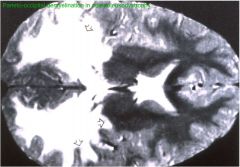
what pathology is shown here? what is its inheritance pattern and what does it cause?
|
parieto-occipital demyelination in adrenoleukodystrophy
x-linked recessive (more severe in men); leads to defect in peroxisomal membrane protein that imports acyl coenzyme A synthetase into peroxisome (so pt has eleveated plasma long chain fatty acid esters -- can't break down fatty acids in peroxisomes) |
|
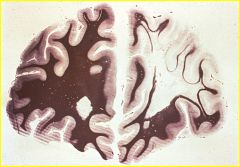
what pathology/dz is this showing and what does it show up as clincally?
|
left (frontal coronal section)
right(parietal coronal section) shows selective parieto-occipital demyelination in adrenoleukodystrophy clincally, problems with spinal cord and pperipheral nerves |
|
|
what dietary supplement can arrest progression of adrenoleukodystrophy?
|
lorenzo's oil
|

